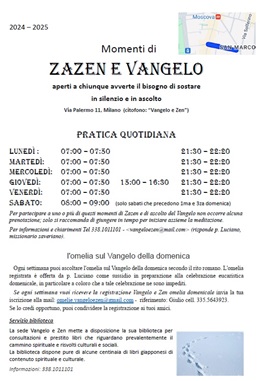* 4. Sitting with Rabbi Jesus
In the Zen tradition the role of the ‘teacher’ or ‘master’ (rōshi) is fundamental. One of the most striking characteristics of the Zen tradition in regard to other Buddhist schools is its seeming ‘disregard’ not only for other forms of rituals and spoken prayers, but also of the sutras or sacred writings of Buddhism. The central role is held by the teacher. It is he that will pass on to the disciples the experience of enlightenment transmitted through countless generations from the ‘Enlighted Dne’, Le., the Buddha Sakya-muni.
The practice of zazen entails a very personal and vital relationship of the disciple to his or her teacher. This guidance or relationship will have different and various expressions [10], but the relation “teacher-and-disciple” is absolutely essential. This will not simply be a ‘teaching-and-learning’ relationship. It will be a vital passing on of the experience of the teacher to his disciple.
In the practice of prayer before the Blessed Sacrament, the attitudes of adoration and worship are commonly expressed, not so much the attitude of the disciple sitting at the feet of his or her teacher. And even when we put ourselves in this mental attitude, we take it most of the time as the attitude of the disciple who learns from the words of his/her teacher what to know, what to do. At times we enjoy perhaps the attitude of just being with Christ in a silent exchange of love and communion of heart. But rarely, perhaps, do we sit at the foot of our teacher Rabbi Jesus with the attitude of the disciple in the Zen tradition, namely with the attitude to receive the very way of being of our rabbi or teacher, to have his interior experience of the Father becoming our own!
The deep existential, vital, relation of the Zen disciple sitting with his or her master could be a very good model on which to mold our attitude in the prayer before Christ in the sacrament of his Body.
The Gospel tells us that Jesus acknowledged explicitly His role as teacher (rabbi) among His disciples (Jn 13: 13-14, Mt 23: 5). Recent theological research in Asia has underscored this ‘messianic title’ of Christ as particularly suited to Asian cultures and spirituality.[11] The practice of zazen before the Blessed Sacrament could help Christians in Japan to experience and to express their relationship to Christ through this fundamental concept of Asian religious tradition.
The practice of zazen in this regard would underline the fact that to be disciples of Jesus means much more than knowing with the head or even believing with the heart his teaching.
It means to become one with him, living his intimate experience of the Father, and his self-giving love for the world. This more’ existential’, praxis oriented conception of the discipleship in Christian tradition could very well be one of the main themes for the inculturation of Christianity in Asia.
| The ‘Great Death’ « | » “Rising from the cushion like a Bodhisattva!” |





